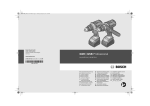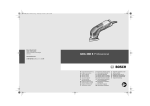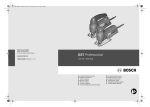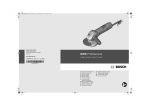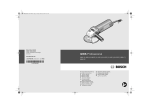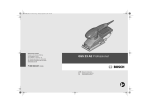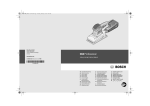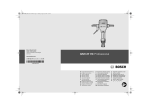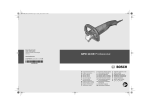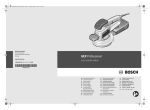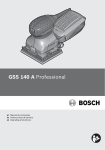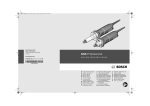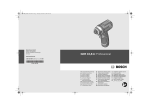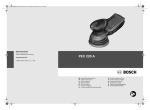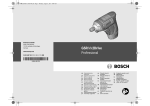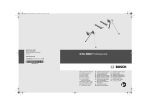Download Bosch GSS 230 A PROFESSIONAL Operating instructions
Transcript
OBJ_DOKU-7115-004.fm Page 1 Monday, December 6, 2010 8:23 AM Robert Bosch GmbH Power Tools Division 70745 Leinfelden-Echterdingen Germany www.bosch-pt.com 2 609 932 790 (2010.12) O / 255 UNI GSS Professional 230 A | 230 AE | 280 A | 280 AE de en fr es pt it nl Originalbetriebsanleitung Original instructions Notice originale Manual original Manual original Istruzioni originali Oorspronkelijke gebruiksaanwijzing da Original brugsanvisning sv Bruksanvisning i original no Original driftsinstruks fi Alkuperäiset ohjeet el tr pl cs sk hu ru Πρωτότυπο οδηγιών χρήσης Orijinal işletme talimat Instrukcja oryginalna Původní návod k používání Pôvodný návod na použitie Eredeti használati utasítás Оригинальное руководство по эксплуатации uk Оригінальна інструкція з експлуатації ro Instrucţiuni originale bg Оригинална инструкция sr sl hr et lv lt ar fa Originalno uputstvo za rad Izvirna navodila Originalne upute za rad Algupärane kasutusjuhend Instrukcijas oriģinālvalodā Originali instrukcija ΔϴϠλϷ ϞϴϐθΘϟ ΕΎϤϴϠόΗ ̶Ϡλ έΎ̯ ίήσ ̵ΎϤϨϫέ OBJ_BUCH-426-004.book Page 3 Monday, December 6, 2010 8:24 AM 3| 4 5 3 2 6 7 1 8 9 10 11 1 GSS 230 AE GSS 280 AE Professional 2 609 932 790 | (6.12.10) Bosch Power Tools OBJ_BUCH-426-004.book Page 4 Monday, December 6, 2010 8:24 AM 4| A1 A2 13 12 15 6 14 6 A3 A4 16 B 17 18 14 2 609 932 790 | (6.12.10) Bosch Power Tools OBJ_BUCH-426-004.book Page 5 Monday, December 6, 2010 8:24 AM 5| C D 9 10 19 19 E F 21 8 9 20 G H 25 22 26 25 23 24 2 609 932 790 | (6.12.10) 19 21 Bosch Power Tools OBJ_BUCH-426-004.book Page 14 Monday, December 6, 2010 8:24 AM 14 | English Safety Notes en General Power Tool Safety Warnings WARNING Read all safety warnings and all instructions. Failure to follow the warnings and instructions may result in electric shock, fire and/or serious injury. Save all warnings and instructions for future reference. The term “power tool” in the warnings refers to your mains-operated (corded) power tool or battery-operated (cordless) power tool. 1) Work area safety a) Keep work area clean and well lit. Cluttered or dark areas invite accidents. b) Do not operate power tools in explosive atmospheres, such as in the presence of flammable liquids, gases or dust. Power tools create sparks which may ignite the dust or fumes. c) Keep children and bystanders away while operating a power tool. Distractions can cause you to lose control. 2) Electrical safety a) Power tool plugs must match the outlet. Never modify the plug in any way. Do not use any adapter plugs with earthed (grounded) power tools. Unmodified plugs and matching outlets will reduce risk of electric shock. b) Avoid body contact with earthed or grounded surfaces, such as pipes, radiators, ranges and refrigerators. There is an increased risk of electric shock if your body is earthed or grounded. c) Do not expose power tools to rain or wet conditions. Water entering a power tool will increase the risk of electric shock. d) Do not abuse the cord. Never use the cord for carrying, pulling or unplugging the power tool. Keep cord away from heat, oil, sharp edges and moving parts. Damaged or entangled cords increase the risk of electric shock. 2 609 932 790 | (6.12.10) e) When operating a power tool outdoors, use an extension cord suitable for outdoor use. Use of a cord suitable for outdoor use reduces the risk of electric shock. f) If operating a power tool in a damp location is unavoidable, use a residual current device (RCD) protected supply. Use of an RCD reduces the risk of electric shock. 3) Personal safety a) Stay alert, watch what you are doing and use common sense when operating a power tool. Do not use a power tool while you are tired or under the influence of drugs, alcohol or medication. A moment of inattention while operating power tools may result in serious personal injury. b) Use personal protective equipment. Always wear eye protection. Protective equipment such as dust mask, non-skid safety shoes, hard hat, or hearing protection used for appropriate conditions will reduce personal injuries. c) Prevent unintentional starting. Ensure the switch is in the off-position before connecting to power source and/or battery pack, picking up or carrying the tool. Carrying power tools with your finger on the switch or energising power tools that have the switch on invites accidents. d) Remove any adjusting key or wrench before turning the power tool on. A wrench or a key left attached to a rotating part of the power tool may result in personal injury. e) Do not overreach. Keep proper footing and balance at all times. This enables better control of the power tool in unexpected situations. f) Dress properly. Do not wear loose clothing or jewellery. Keep your hair, clothing and gloves away from moving parts. Loose clothes, jewellery or long hair can be caught in moving parts. Bosch Power Tools OBJ_BUCH-426-004.book Page 15 Monday, December 6, 2010 8:24 AM English | 15 g) If devices are provided for the connection of dust extraction and collection facilities, ensure these are connected and properly used. Use of dust collection can reduce dust-related hazards. 4) Power tool use and care a) Do not force the power tool. Use the correct power tool for your application. The correct power tool will do the job better and safer at the rate for which it was designed. b) Do not use the power tool if the switch does not turn it on and off. Any power tool that cannot be controlled with the switch is dangerous and must be repaired. c) Disconnect the plug from the power source and/or the battery pack from the power tool before making any adjustments, changing accessories, or storing power tools. Such preventive safety measures reduce the risk of starting the power tool accidentally. d) Store idle power tools out of the reach of children and do not allow persons unfamiliar with the power tool or these instructions to operate the power tool. Power tools are dangerous in the hands of untrained users. e) Maintain power tools. Check for misalignment or binding of moving parts, breakage of parts and any other condition that may affect the power tool’s operation. If damaged, have the power tool repaired before use. Many accidents are caused by poorly maintained power tools. f) Keep cutting tools sharp and clean. Properly maintained cutting tools with sharp cutting edges are less likely to bind and are easier to control. g) Use the power tool, accessories and tool bits etc. in accordance with these instructions, taking into account the working conditions and the work to be performed. Use of the power tool for operations different from those intended could result in a hazardous situation. Bosch Power Tools 5) Service a) Have your power tool serviced by a qualified repair person using only identical replacement parts. This will ensure that the safety of the power tool is maintained. Safety Warnings for Sander f Use the machine only for dry sanding. Penetration of water into the machine increases the risk of an electric shock. f Caution, fire hazard! Avoid overheating the object being sanded as well as the sander. Always empty the dust collector before taking breaks. In unfavourable conditions, e. g., when sparks emit from sanding metals, sanding debris in the dust bag, micro filter or paper sack (or in the filter sack or filter of the vacuum cleaner) can self-ignite. Particularly when mixed with remainders of varnish, polyurethane or other chemical materials and when the sanding debris is hot after long periods of working. f When working with the machine, always hold it firmly with both hands and provide for a secure stance. The power tool is guided more secure with both hands. f Secure the workpiece. A workpiece clamped with clamping devices or in a vice is held more secure than by hand. Products sold in GB only: Your product is fitted with an BS 1363/A approved electric plug with internal fuse (ASTA approved to BS 1362). If the plug is not suitable for your socket outlets, it should be cut off and an appropriate plug fitted in its place by an authorised customer service agent. The replacement plug should have the same fuse rating as the original plug. The severed plug must be disposed of to avoid a possible shock hazard and should never be inserted into a mains socket elsewhere. Products sold in AUS and NZ only: Use a residual current device (RCD) with a rated residual current of 30 mA or less. 2 609 932 790 | (6.12.10) OBJ_BUCH-426-004.book Page 16 Monday, December 6, 2010 8:24 AM 16 | English Functional Description Read all safety warnings and all instructions. Failure to follow the warnings and instructions may result in electric shock, fire and/or serious injury. While reading the operating instructions, unfold the graphics page for the machine and leave it open. 23 Sanding plate, extended* 24 Screws for extended sanding plate* 25 Triangular sanding sheet* 26 Triangular sanding plate, extended* *Accessories shown or described are not part of the standard delivery scope of the product. A complete overview of accessories can be found in our accessories program. Intended Use The machine is intended for dry sanding of wood, plastic, filler and coated surfaces. Product Features The numbering of the product features refers to the illustration of the machine on the graphics page. 1 Auxiliary handle (insulated gripping surface) 2 Screw for auxiliary handle 3 Thumbwheel for orbit frequency preselection (GSS 230 AE/GSS 280 AE) 4 On/Off switch 5 Lock-on button for On/Off switch 6 Dust box, complete (Microfilter System)* 7 Allen key 8 Sanding-sheet clamp 9 Sanding plate 10 Clamping bracket 11 Handle (insulated gripping surface) 12 Holder for dust box* 13 Plastic slider 14 Extraction outlet 15 Latching lever for dust box* 16 Filter element (Microfilter System)* 17 Extraction adapter* 18 Vacuum hose* 19 Sanding sheet* 20 Perforating tool* 21 Screws for sanding plate 22 Sanding plate, thin, extended* 2 609 932 790 | (6.12.10) Bosch Power Tools OBJ_BUCH-426-004.book Page 17 Monday, December 6, 2010 8:24 AM English | 17 Technical Data Orbital sander GSS ... Professional Article number 0 601 ... Dust box included in delivery scope Preselection of orbital stroke rate 230 A 230 AE 230 AE 280 A 280 AE 280 AE 292 0.. 292 7.. 292 6.. 293 0.. 293 7.. 293 6.. – – z – – z – z z – z z W 300 300 300 330 330 330 min-1 11000 5500 – 11000 5500 – 11000 11000 5500 – 11000 5500 – 11000 No-load orbital stroke rate min-1 22000 11000 – 22000 11000 – 22000 22000 11000 – 22000 11000 – 22000 Orbit diameter mm 2.4 2.4 2.4 2.4 2.4 2.4 mm 93 x 185 93 x 185 93 x 185 115 x 230 115 x 230 115 x 230 mm 93 x 230 93 x 230 93 x 230 115 x 280 115 x 280 115 x 280 mm 92 x 182 92 x 182 92 x 182 114 x 226 114 x 226 114 x 226 kg 2.3 2.3 2.3 2.6 2.6 2.6 /II /II /II /II /II /II Rated power input No-load speed Sanding sheet dimensions — Adhesion via Velcro backing — Attachment via clamping Sanding plate dimensions Weight according to EPTA-Procedure 01/2003 Protection class The values given are valid for a nominal voltage [U] of 230 V. For different voltages and models for specific countries, these values can vary. Please observe the article number on the type plate of your machine. The trade names of the individual machines may vary. Noise/Vibration Information Measured sound values determined according to EN 60745. Typically the A-weighted sound pressure level of the product is 76 dB(A). Uncertainty K=3 dB. The noise level when working can exceed 80 dB(A). Wear hearing protection! Bosch Power Tools Vibration total values (triax vector sum) determined according to EN 60745: Vibration emission value ah =4.5 m/s2, Uncertainty K =1.5 m/s2. The vibration emission level given in this information sheet has been measured in accordance with a standardised test given in EN 60745 and may be used to compare one tool with another. It may be used for a preliminary assessment of exposure. The declared vibration emission level represents the main applications of the tool. However if the tool is used for different applications, with 2 609 932 790 | (6.12.10) OBJ_BUCH-426-004.book Page 18 Monday, December 6, 2010 8:24 AM 18 | English different accessories or poorly maintained, the vibration emission may differ. This may significantly increase the exposure level over the total working period. An estimation of the level of exposure to vibration should also take into account the times when the tool is switched off or when it is running but not actually doing the job. This may significantly reduce the exposure level over the total working period. Identify additional safety measures to protect the operator from the effects of vibration such as: maintain the tool and the accessories, keep the hands warm, organisation of work patterns. Declaration of Conformity We declare under our sole responsibility that the product described under “Technical Data” is in conformity with the following standards or standardization documents: EN 60745 according to the provisions of the directives 2004/108/EC, 2006/42/EC. Technical file at: Robert Bosch GmbH, PT/ESC, D-70745 Leinfelden-Echterdingen Dr. Egbert Schneider Senior Vice President Engineering Dr. Eckerhard Strötgen Head of Product Certification Certain dusts, such as oak or beech dust, are considered as carcinogenic, especially in connection with wood-treatment additives (chromate, wood preservative). Materials containing asbestos may only be worked by specialists. – As far as possible, use a dust extraction system suitable for the material. – Provide for good ventilation of the working place. – It is recommended to wear a P2 filterclass respirator. Observe the relevant regulations in your country for the materials to be worked. f Prevent dust accumulation at the workplace. Dusts can easily ignite. Integrated Dust Extraction with Dust Box (see Fig. A1 – A4) Before assembling the dust box 6, pull out the plastic slider 13. Place the dust box 6 onto the extraction outlet 14 and allow it to engage. Make sure that the plastic slider 13 engages in the holder 12. To empty the dust box 6, press the latching levers 15 on the side of the dust box (n). Pull off the dust box toward the bottom (o). Before opening the dust box 6, it is recommended to loosen the dust from the filter element by gently striking it against a firm support (as shown in the figure). Robert Bosch GmbH, Power Tools Division D-70745 Leinfelden-Echterdingen 09.11.2010 Grasp the dust box 6 by the recessed grip, fold the filter element 16 upward and empty the dust box. Clean the thin plates of the filter element 16 with a soft brush. Assembly External Dust Extraction (see figure B) f Before any work on the machine itself, pull the mains plug. Dust/Chip Extraction f Dusts from materials such as lead-containing coatings, some wood types, minerals and metal can be harmful to one’s health. Touching or breathing-in the dusts can cause allergic reactions and/or lead to respiratory infections of the user or bystanders. 2 609 932 790 | (6.12.10) Slide the extraction adapter 17 onto the outlet piece 14. Ensure that the latching levers of the extraction adapter engage. The extraction adapter 17 accepts a vacuum hose with a diameter of 19 mm. For removal of the extraction adapter 17, press the latching levers together at the rear and pull the extraction adapter off. The vacuum cleaner must be suitable for the material being worked. Bosch Power Tools OBJ_BUCH-426-004.book Page 19 Monday, December 6, 2010 8:24 AM English | 19 When vacuuming dry dust that is especially detrimental to health or carcinogenic, use a special vacuum cleaner. Replacing the Sanding Sheet When attaching a new sanding sheet, remove any dust or debris from the sanding plate 9 (e. g. with a brush). To ensure optimum dust extraction, pay attention that the punched holes in the sanding sheet match with the holes in the sanding plate. Sanding Sheets with Velcro Backing (see figure C) Sanding sheets without holes, e. g. from rolls or by the meter, can be punctured with the perforating tool 20 for use with dust extraction. For this, press the machine with the mounted sanding sheet onto the perforating tool (see figure E). To remove the sanding sheet 19, unlatch the sanding-sheet clamp 8 and pull out the sanding sheet. Selecting the Sanding Sheet Depending on the material to be worked and the required rate of material removal, different sanding sheets are available: The sanding plate 9 is fitted with Velcro backing for quick and easy fastening of sanding sheets with Velcro adhesion. Before attaching the sanding sheet 19, free the Velcro backing of the sanding plate 9 from any debris by tapping against it in order to enable optimum adhesion. Position the sanding sheet 19 flush alongside one edge of the sanding plate 9, then lay the sanding sheet onto the sanding plate and press firmly. To remove the sanding sheet 19, grasp it at one of the tips and pull it off from the sanding plate 9. Sanding Sheets without Velcro Backing (see figure D) Lightly lift and unlatch the sanding-sheet clamp 8. Grain size 40—240 For the working of all wooden materials For coarse-sanding, e. g. of rough, unplaned beams and boards coarse 40, 60 For face sanding and planing small irregularities medium 80, 100, 120 For finish and fine sanding of hard woods fine 180, 240 40—320 For the working of paint/enamel coats or primers and fillers Guide the sanding sheet 19 under the opened rear clamping bracket 10 to the stop and clamp the sanding sheet by reinserting the sandingsheet clamp 8. For sanding off paint coarse 40, 60 For sanding primer medium 80, 100, 120 Fold the sanding sheet 19 firmly around the sanding plate. Guide the other end of the sanding sheet 19 under the open front clamping bracket 10 and clamp the sanding sheet by reinserting the sanding-sheet clamp 8. For final sanding of prim- fine ers before coating 180, 240, 320 Replacing the Sanding Plate (see figure F) The sanding plate 9 can be replaced, if required. Unscrew the 6 screws 21 completely and remove the sanding plate 9. Attach the new sanding plate 9 and tighten the screws again. Bosch Power Tools 2 609 932 790 | (6.12.10) OBJ_BUCH-426-004.book Page 20 Monday, December 6, 2010 8:24 AM 20 | English Specialty Sanding Plates You can replace the supplied sanding plate 9 with a specialty sanding plate, which is available as an accessory. The specialty sanding plate is attached in the same manner as the one supplied. Attach and remove the respective sanding sheets in the same manner as when changing original sanding sheets. Operation Starting Operation f Observe correct mains voltage! The voltage of the power source must agree with the voltage specified on the nameplate of the machine. Power tools marked with 230 V can also be operated with 220 V. Switching On and Off Extended Sanding Plate, Rectangular, Thin (GSS 230 A/GSS 230 AE) (see figure G) To start the machine, press the On/Off switch 4 and keep it pressed. Use of the rectangular, thin, extended sanding plate 22 enables sanding at hard-to-reach locations and narrow interspaces, e. g. on window and door sills, grooves or behind radiators or water pipes. To lock the pressed On/Off switch 4, press the lock-on button 5. To mount the rectangular, thin, extended sanding plate 22, use the corresponding screws 24. Extended Sanding Plate, Triangular (GSS 230 A/GSS 230 AE) (see figure H) Use of the extended triangular sanding plate 26 enables sanding in edges and corners. Finish-sanding Plate (without velcro backing) (GSS 230 AE/GSS 280 AE) (see figure D) To switch off the machine, release the On/Off switch 4 or when it is locked with the lock-on button 5, briefly press the On/Off switch 4 and then release it. Preselecting the Orbital Stroke Rate (GSS 230 AE/GSS 280 AE) With the thumbwheel for preselection of the orbital stroke rate 3, you can preselect the required orbital stroke rate, even during operation. The required stroke rate depends on the material and the working conditions and can be determined through practical testing. When operating mainly with standard sanding sheets without velcro backing, it is recommended to use the finish-sanding plate without velcro backing. Due to its plane sanding plate surface, optimum results are achieved, especially for finish sanding. Working Advice Auxiliary Handle The removal capacity during sanding is mainly determined by the selection of the sanding sheet as well as the preselected orbital stroke rate (GSS 230 AE/GSS 280 AE). The auxiliary handle 1 enables convenient handling and optimal distribution of power, especially at high removal rates. Fasten the auxiliary handle 1 with screw 2 to the casing. f Wait until the machine has come to a standstill before placing it down. Only flawless sanding sheets achieve good sanding capacity and extend the service life of the machine. Pay attention to apply uniform sanding pressure; this increases the working life of the sanding sheets. Intensifiying the sanding pressure does not lead to an increase of the sanding capacity, but to increased wear of the machine and the sanding sheet. 2 609 932 790 | (6.12.10) Bosch Power Tools OBJ_BUCH-426-004.book Page 21 Monday, December 6, 2010 8:24 AM English | 21 A sanding sheet that has been used for metal should not be used for other materials. Use only original Bosch sanding accessories. Maintenance and Service Maintenance and Cleaning f Before any work on the machine itself, pull the mains plug. f For safe and proper working, always keep the machine and ventilation slots clean. If the machine should fail despite the care taken in manufacturing and testing procedures, repair should be carried out by an after-sales service centre for Bosch power tools. In all correspondence and spare parts order, please always include the 10-digit article number given on the type plate of the machine. After-sales Service and Customer Assistance Our after-sales service responds to your questions concerning maintenance and repair of your product as well as spare parts. Exploded views and information on spare parts can also be found under: www.bosch-pt.com Our customer service representatives can answer your questions concerning possible applications and adjustment of products and accessories. Great Britain Robert Bosch Ltd. (B.S.C.) P.O. Box 98 Broadwater Park North Orbital Road Denham Uxbridge UB 9 5HJ Tel. Service: +44 (0844) 736 0109 Fax: +44 (0844) 736 0146 E-Mail: [email protected] Bosch Power Tools Ireland Origo Ltd. Unit 23 Magna Drive Magna Business Park City West Dublin 24 Tel. Service: +353 (01) 4 66 67 00 Fax: +353 (01) 4 66 68 88 Australia, New Zealand and Pacific Islands Robert Bosch Australia Pty. Ltd. Power Tools Locked Bag 66 Clayton South VIC 3169 Customer Contact Center Inside Australia: Phone: +61 (01300) 307 044 Fax: +61 (01300) 307 045 Inside New Zealand: Phone: +64 (0800) 543 353 Fax: +64 (0800) 428 570 Outside AU and NZ: Phone: +61 (03) 9541 5555 www.bosch.com.au Republic of South Africa Customer service Hotline: +27 (011) 6 51 96 00 Gauteng – BSC Service Centre 35 Roper Street, New Centre Johannesburg Tel.: +27 (011) 4 93 93 75 Fax: +27 (011) 4 93 01 26 E-Mail: [email protected] KZN – BSC Service Centre Unit E, Almar Centre 143 Crompton Street Pinetown Tel.: +27 (031) 7 01 21 20 Fax: +27 (031) 7 01 24 46 E-Mail: [email protected] Western Cape – BSC Service Centre Democracy Way, Prosperity Park Milnerton Tel.: +27 (021) 5 51 25 77 Fax: +27 (021) 5 51 32 23 E-Mail: [email protected] 2 609 932 790 | (6.12.10) OBJ_BUCH-426-004.book Page 22 Monday, December 6, 2010 8:24 AM 22 | English Bosch Headquarters Midrand, Gauteng Tel.: +27 (011) 6 51 96 00 Fax: +27 (011) 6 51 98 80 E-Mail: [email protected] Disposal The machine, accessories and packaging should be sorted for environmental-friendly recycling. Do not dispose of power tools into household waste! Only for EC countries: According the European Guideline 2002/96/EC for Waste Electrical and Electronic Equipment and its implementation into national right, power tools that are no longer usable must be collected separately and disposed of in an environmentally correct manner. Subject to change without notice. 2 609 932 790 | (6.12.10) Bosch Power Tools













